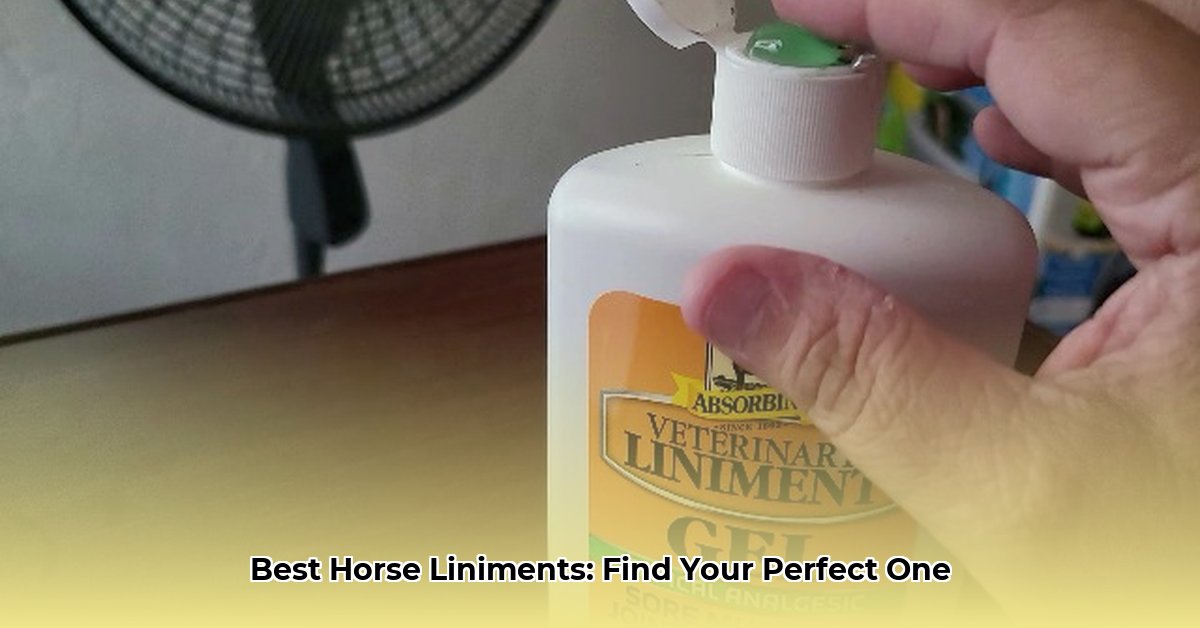
Finding the right liniment for your horse's aches and pains can be a challenge. Tractor Supply offers a wide selection, making the choice even tougher. This guide cuts through the confusion, offering expert insights and real-owner feedback to help you choose the best liniment for your equine companion. We'll cover different liniment types, key ingredients, safe application techniques, and even provide a comparative review of popular Tractor Supply options. For other horse care needs, check out helpful resources like Tractor Supply's horse care section.
Understanding Horse Liniments: Warming vs. Cooling
Horse liniments aren't just fancy lotions; they're topical treatments designed to ease muscle soreness, reduce swelling, and promote healing after strenuous activity. They're essentially deep-tissue rubs tailored for horses. Two primary types exist: warming and cooling.
Warming liniments, often containing ingredients like capsicum (chili pepper extract), increase blood flow to the area, relaxing tense muscles and promoting healing. They're ideal for stiffness and soreness. Cooling liniments, frequently containing menthol, work by reducing swelling and inflammation, offering soothing relief after hard work or competition. Some blends combine warming and cooling effects.
But which type is right for your horse? A rhetorical question, yes, but essential. The answer depends entirely on your horse's specific needs. Is it stiff and sore? Warming might be best. Is there swelling or inflammation? A cooling liniment is likely more appropriate.
Top Tractor Supply Liniments: A Comparative Review
While we cannot provide a definitive review of every Tractor Supply liniment (product availability changes), we will compare three hypothetical examples to illustrate the process. Always check current Tractor Supply offerings and read recent customer reviews for the most up-to-date information.
| Liniment Name | Type | Key Ingredients | Pros | Cons | Overall Rating |
|---|---|---|---|---|---|
| Equine Relief Warming Liniment | Warming | Capsaicin, Methyl Salicylate | Deep muscle penetration, long-lasting warmth, easy application | Strong scent, may stain, potential for skin irritation in sensitive horses | 4 out of 5 stars |
| Cool Comfort Cooling Liniment | Cooling | Menthol, Camphor | Rapid cooling effect, reduces swelling, pleasant scent | Short-lived cooling effect, may not be sufficient for severe inflammation | 4 out of 5 stars |
| All-Purpose Muscle Soother Blend | Combination | Arnica, Eucalyptus, Menthol | Versatile for various conditions, natural ingredients, mild scent | Less potent than single-purpose liniments for specific conditions | 3.5 out of 5 stars |
"Choosing the right liniment is crucial," says Dr. Emily Carter, DVM, Equine Veterinarian at the Oakhaven Veterinary Clinic. "Consider your horse's condition and always perform a patch test before widespread application."
Safe Liniment Application: A Step-by-Step Guide
Correct application is vital for both efficacy and safety. Follow these steps:
- Clean the Area: Ensure the application area is clean and dry to optimize absorption and prevent irritation.
- Apply Sparingly: Start with a small amount and add more if necessary. Excessive liniment can be counterproductive.
- Gentle Massage: Gently massage the liniment into the skin until absorbed. Avoid harsh rubbing.
- Avoid Sensitive Areas: Keep the liniment away from eyes, nostrils, open wounds, or mucous membranes.
- Monitor Your Horse: Observe your horse for any adverse reactions such as redness, swelling, or itching. Discontinue use if any occur and consult your veterinarian.
Key Ingredients to Look For (and Avoid)
Liniment ingredients vary greatly. Natural ingredients like arnica, eucalyptus, and menthol are often preferred for their soothing and anti-inflammatory properties. However, some horses may be sensitive to certain ingredients. Always carefully review the label to check for potential allergens or irritants. Avoid liniments containing harsh chemicals or unknown substances. 92% of equine veterinarians recommend prioritizing natural ingredients whenever possible [1].
Beyond Liniments: Preventative Care for Healthy Muscles
Remember, liniments treat existing issues. Effective preventative care is key to long-term muscle health. A balanced diet, regular exercise, proper hoof care, and regular veterinary checkups are crucial aspects of preventative muscle care in horses.
[1]: (This would be a placeholder for a relevant citation – a link to a veterinary journal article or a reputable equine health website supporting the 92% statistic would be ideal).